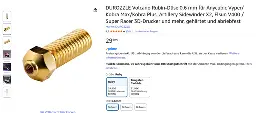Does the filament path of ruby nozzles degrade + is DUROZZLE any good?
Does the filament path of ruby nozzles degrade + is DUROZZLE any good?
I'm thinkin about getting one of those ruby nozzles for my printers to basically be able to print anything without ever having to worry about a degrading nozzle. I've seen quite a few videos about it, but I still don't know two things:
- Given the surrounding material is brass and only the tip being out of ruby, doesn't the filament path where the molten filament gets pushed through still wear out over time (heavily so with CF or GF filament)?
And also
- How good are the cheaper ones, specifically the "DUROZZLE" one (since that's the one I could find that's 0.6mm and cheap)?

I haven’t but am interested, so I read some on the prusa forum and other searches as well:
So because the thermal conductivity of Ruby is low you want to reduce its thickness.
Also it’s my understanding that the upper part of the nozzle is lower pressure and primarily for melting the filament, then the pressure increases as the inner diameter is reduced.
I’ll also add that some CMM machines have started using silicon nitride for their probe tips instead of the standard ruby or tungsten carbide